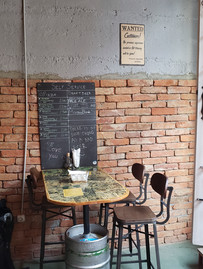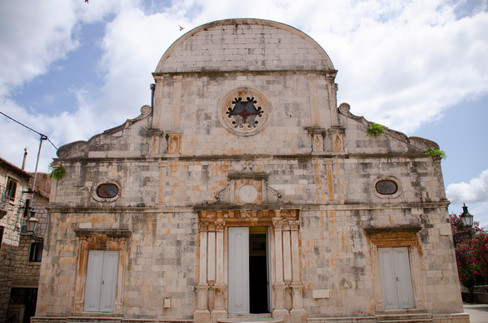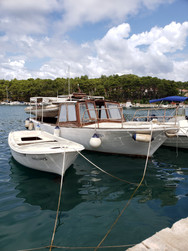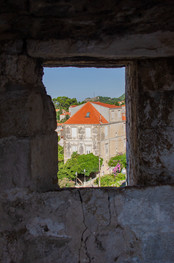Europe 2019 - Part 2 - Croatia
- Tony
- Aug 5, 2019
- 26 min read
Updated: Sep 23
Six Countries in 21 Days Including a Croatian Island Yacht Cruise
July/August 2019
Continued from Part 1 of our 21 day Europe trip post that covered Germany, Austria, Switzerland and Italy, next up is Croatia and our 8 day small yacht cruise of the Dalmatian Islands and Coast.
Make sure to click on the < or > arrows in the photos to view all in each group
CROATIA
Up before dawn and impressed that everyone in the group rallied to be in the van by 5:00 am! A small miracle considering the cat herding that is sometimes required when traveling with a group of independent-minded travelers who enjoy late nights and adult beverages. We’re off to the airport and our short flight on Volotea airlines to Split, Croatia.
A few words on low-cost European commuter airlines while we're on the subject…While the initial cost may be appealing, most travelers other than business commuters will pay significantly more once all the fees for bags, seat assignments, boarding passes, etc… are paid. The price is still very reasonable but nowhere near the initial quotes. For example, our flight was quoted at $15 each but once all was added in they were about $100 each, Still very reasonable. The airport was packed but seemed to move efficiently, security was quick, there was a long walk through a maze of shops then through passport check and off to the gate where we were delayed about 30 minutes before boarding. An efficient hour and twenty-minute flight and we’re landing in Split
What we liked about Croatia
Just about everything! Except for the crowds in Split and Dubrovnik
Deep blue waters of the Adriatic and Dalmatian coast
Small Yacht cruising is very popular here. Be careful about which cruise you choose as they range from bare-bones (shared bathrooms) ships to upscale full service. We used Sail Croatia and selected the “Explorer” cruise which is “Best suited for couples, young professionals and 'young at heart' travelers” and were pleased with our choice
SAIL Croatia - We were a group of 9 friends on an extended European trip this summer, including a 7-day small yacht cruise aboard Cristal. The ship and its amenities were perfect, the itinerary was amazing, including the stops for swimming and the ports of Stari-Grad, Hvar, and Korcula. The other shipmates, from Australia, New Zealand, USA, Peru, and England were all a perfect match in personalities and similar interests making the cruise even more enjoyable. Mia our cruise director was very helpful in organizing activities and restaurants.
History! This is a country that was in the middle of many geographic migrations; Greeks, Romans (dating back to the 4th century BC!), Venetians, Ottomans, Habsburg Monarchy, etc… This has left many wonderful remains dotting the country in the form of ruins, preserved villages, fortresses, and evidence of farming and everyday life.
Croatian Wine – Good value, mostly warm climate varietals like Sauvignon blanc and Plavac Mali (Zinfandel). Hearty reds, dry white and rose wines. We found good quality Plavac Mali (Grgic), Dingac and Grc (White)
Currency – Croatia is one of the newest members of the EU but has not yet transitioned their currents to the Euro. Euros are generally not accepted at most retailers in Croatia. Kuna’s are the currency most widely accepted valued at about .15 to the dollar. Most places will accept cash only (mainly to avoid high taxes) but if pushed they will break out the credit card machine for your transaction. ATM’s are everywhere should you need access to Kuna, be aware and select BANK sponsored machines over independent ones to avoid additional fees for your transaction.
The bread and pastries – sample from one of the many bakeries at each stop. Our favorites were the Börek savory spinach and cheese pastries and pizza-like flatbread
SPLIT
Landing in split at a small but modern airport we made a connection with our drivers who we previously scheduled for the trip to our old town hotel. Weather is warm but not oppressive as it was in Lake Como. Split is larger than expected, the second largest town in Croatia with 178,000 residents is second only to Zagreb the capital city with nearly 700,000 residents. Situated on the Dalmatian coast along the Adriatic Sea its best known for its beaches and fortress-like complex at its center. Diocletian’s Palace erected by the Roman emperor in the 4th century. Once home to thousands, its sprawling remains include more than 200 buildings. Within its white stone walls and under its courtyard and galleries are shops, restaurants, bars, cafes, cathedrals, hotels and several houses. We booked rooms at the Royal Suites which turned out to be one of only a handful (5) of small hotels located within the old town area. We were greeted in a nearby parking lot by hotel staff who escorted us into what looked like an apartment building and had us wait in a small room used as their breakfast restaurant. We were then escorted to the 8th-floor check-in desk where the total of 8 hotel rooms resided encompassing the entire hotel inventory! Odd and a bit quirky but the rooms were very nice and worked out well for the group especially considering the location within a short walking distance of attractions and our departure point in the morning.
Once settled in we set out to explore split and found a restaurant Bakra a steak and pizza bar touting a 72-year-old wood-fired oven near the hotel where we stopped in for lunch. The building was probably 15th century or earlier as are most of the structures in the old town area. After some really good pizza and beer, we made our way to the Palace area walking through the hundreds of street vendor stalls and canopy-covered water facing restaurants. A very busy port was just to our left where hundreds of small cruise boats similar in size to the one we will be on, were docked preparing for tomorrow's boarding. As it turns out most of the cruises depart on Saturday which must place a huge strain on the town. Seems like they would be better off spreading the departures out by scheduling on different days? The Palace and Roman ruins were amazingly well preserved given the amount of foot traffic. Several shops and restaurants occupy old buildings within the complex. Some of the waterfront restaurants have built modern facades in front of the ruins which seems odd but I image helps to protect the ancient structures.
Later that night we stopped in Mandrill Nano Brewing, a small cozy microbrewery adjacent to the hotel with very good local beer. They have a beer tap on a bicycle parked out front in case they need to be mobile? We moved next to dinner at Zinfandel, a restaurant inside the palace ruins. Croatians are very proud of their wines and this restaurant was no exception. They had a broad selection and explained each wine in-depth as they brought them to our table. I do have to admit that some of their wines are very good. Since the growing climate is very warm and dry most wines produced are heavy and bold. Zinfandel is said to have originated from Croatia in a grape called Plavix Mali. There was a bit of a scare during dinner, we couldn’t see outside based on our table location but apparently, the crowds outside started running and patrons inside our restaurant near the front got up and hid towards the rear near our table. Turns out many of the travelers in town are from areas of high volatility and viewed the events as potential terrorism. What happened was a nearby restaurant had a small gas explosion and fire followed by a strong fire department response. Dinner was good as we sampled many dishes that were local influenced, Seafood is big here with Seabass and Octopus, Lamb and Pasta were also big, Potatoes and Chard are staples of the diet and accompany many dishes. On our way out the town was just beginning to party with club music and lights filling the streets, ready to party the night away
After breakfast, we headed to our ship for boarding. Our luggage went to the ship via golf cart escorted by AM and both were waiting for us after a short walk from the hotel. The harbor area was chaotic with hundreds of ships of our size were rafted together awaiting their passengers. Fortunately, ours was first at the dock so unlike others who had to walk through our ship and others we were on board immediately and waiting on the back deck for instructions and our rooms. Once checked in, lunch was served and we were underway to our first destination Makarska.
What we liked about Split
A Very busy port town
Royal Suites Hotel was small and strange layout but nice and great central location. Only 5 small hotels in the old center where we stayed, the rest are a taxi ride away
The Diocletian’s Palace and Roman ruins were amazing but sad to see such an important piece of history turned into a shopping mall.
Saint Domnius Cathedral was small but ornate (most sites charge an entrance fee of max. 10 kunas pp, about $1.50 usd)
Many shops and stalls around selling all kinds of souvenirs and food
MAKARSKA
Cruising the Adriatic to our next destination Makarska, you can see the typical Croatian landscape of rocky light colored limestone shores dotted with ancient villages and structures, stacked stone wall terraced hillsides and pebbled beaches (no sandy beaches here). Makarska is a port town on Croatia’s Dalmatian coast, known for its Riviera beaches (Pebbles not sand), seafront promenade and nightlife. Set on a small bay between wooded headlands, the old town centers on Kačić Square nestled under the massive peaks of the Biokovo mountain range, with Mt. Jure being the highest seaside peak on the Mediterranean. We docked right on the promenade in the center of the city where strolling along the streets you’ll find numerous churches and architectural sights. Not our favorite stop as it lacks the historic charm and sites that our other stops contain. Once you venture to the streets above the promenade you become immersed in less touristic daily life surroundings. A few shops and restaurants dot the back streets along with numerous churches of historic value. We were forced to spend two nights here as opposed to the original schedule of one due to rough seas. We made the most of our stay here dodging the intermittent rain showers by dropping in to cover of the restaurants along the promenade. We walked the promenade and streets, viewed the Cathedral of St. Mark and the Franciscan Monastery of the Virgin Mary then hiked around St. Peters park to view the statue guarding the entry to the port and other ruins and stopped at along the Riviera beach at one of the numerous outdoor bars for an adult beverage.
Dinner on our first night was at Restaurant Riva on a recommendation from our cruise director Mia. The restaurant was all outdoors with great food, whole fresh fish, open fire grilling, attentive service, and an amazing wine selection. They introduced us to a Plavac Mali (Zinfandel) wine from Croatia made by Mike Grgich of Napa Valley fame. Grgich, originally from Croatia has returned to make wine here. It was a bit more expensive than other Croatian wines but well worth the added cost. After dinner, we bought some Cuban cigars from their humidor for later consumption. Very good quality and reasonably priced.
On our second day, Mia our cruise director arranged a wine tasting in what Mia described as the Hinterland (Interior Valley). Through intermittent heavy downpours, we ventured out on an hour-long bus ride over the mountains and into the small narrow roads of the valley behind Makarska we finally arrived at the small modern winery facility of Grabovac winery set among 12th-century homes and buildings in the local farmland. The tasting was fun, wines were okay but the journey with our shipmates through the rain, beautiful countryside and harrowing bus maneuvers were memorable.
We were late getting back to Makarska and the ship causing a slight delay to the scheduled Captains dinner on board. Following dinner, we wandered the streets for a bit then retired to our cabins. A few of the die-hard shipmates ventured out to Club Deep, a nightclub set in a natural cave next to the sea.
What we liked about Makarska
Our first stop docked right at the base of the town. Very little historic value here compared to our other stops.
Walk around St Peters point to the statue, church, cliffs and around to the Riviera beaches, Bars and restaurants
Venture out to the Hinterland (Valley over the hill behind Makarska) for open countryside, ancient farmland, 12th-century structures dotting the narrow roadways and a few wineries. A good area for a road trip.
STARI-GRAD
Early morning, we motored from Makarska toward Stari-Grad for a brief stop before docking for the night in Hvar. On the island of Hvar, Stari-Grad literally means “Old Town” and is one of the oldest towns in Croatia dating back to 200 bc, Stari-Grad boasts an architectural network of old narrow streets, vineyards and olive groves that surround the town, as well as the Stari Grad plain: a Unesco protected world heritage site. We spent the afternoon wandering the streets of this beautiful, secluded, small, quiet town. We were the only cruise Yacht docked there today but many smaller personal and chartered boats lined the low seawall along the promenade. Visited Tvrdalj Petra Hektorovića, the Renaissance era summer residence of Petar Hektorović, the Croatian poet (1487–1572) and the 5th century Church of St John and some ancient ruins .
Departing in the afternoon were heading to Hvar for our overnight catching up to our regular schedule. Sorry we missed the scheduled overnight in Stari-Grad, would have liked more time to enjoy this area
What we liked about Stari-Grad
A Beautiful, small, quiet port town full of historic structures and beautiful walkways to explore
Docked again along the low sea wall on the promenade just in front of the city
Walked by an open door and inside was a small family-run winery Vino Antoni, wines made by grandpa seemed mostly for family consumption. the youngest son Antoni sold us 2 bottles of wine for the equivalent of $9.00
HVAR
On the way to Hvar, we stopped for a swim off the back of the ship in another beautiful cove. The water is clear deep blue and warm here, a refreshing break from the summer heat. Arriving in Hvar along with several other boats were once again rafted side by side along the promenade docked in a prime position along the town front immersed in the atmosphere of restaurants, cafes, and bars. Hvar town located on the island of Hvar is a larger, more popular town filled with locals and tourists and features a 7th-century fortress on a hill overlooking the harbor. Explore the renaissance cathedral with its original tower and discover the oldest community theater in Europe.
Off the boat, we wandered the town, quickly found a bakery for a snack then found a table for beverages at Ka’Landa a great bar situated in an alley of the 14th-century village overlooking the Cathedral and square. After enjoying drinks from their very creative menu, a few of us decided to hike uphill to the fortress.
The Spanish Fortress Looms high above the town today and lit with a golden glow at night, this medieval castle occupies the site of an ancient Illyrian settlement dating from before the 8th century B.C. where on the site stood a fort. Archeological evidence indicates long-distance trade from the eighth century B.C. onward. The views looking down over Hvar and the Pakleni Islands are magnificent and well worth the trudge up through the old-town streets. Once you clear the town walls it's a gently sloping meander up the tree-shaded hillside to the fortress. The Byzantines built a citadel here in the 6th century, and the construction of the current fortress began in 1282 shortly after the town turned to the Venetians for protection against the pirates rampaging through the Adriatic. The town financed the construction from the proceeds of selling salt. At one point in the 14th century, Spanish engineers participated in the project which is how the fort acquired its nickname, Spanjola. It was strengthened in 1551, which may have saved the lives of Hvar's population, who sheltered here in 1571 when the Turks sacked their town. Only eight years later however, a lightning bolt struck the fort igniting a store of gunpowder which blew up and caused substantial damage to the fort and its substructure. Repairs ensued and when the Austrians took over in the early 19th century, the fortress was remodeled with larger barracks and raised battlements. By the end of the century though, Hvar had lost its strategic importance and the fort fell into disrepair. Before its recent overhaul and transformation into a historic monument, the fortress was the site of a popular disco. Inside there's a collection of ancient amphorae recovered from the seabed, along with a terrace cafe.
Following our visit to the fortress, we continued our exploration of the city, did a little shopping and stopped for a Gelato (Gelato stands are everywhere in each town we stopped).
Dinner tonight was at Luviji on a recommendation from Mia. She told us to chose the downstairs restaurant which consisted of about 8 tables outside on the cobblestone walkway as opposed to the larger restaurant upstairs. Good call as this kitchen featured a more traditional menu, great service and an amazing outdoor location off the beaten path. Great food and wine were enjoyed.
What we liked about Hvar
A busy popular port town where we once again docked with several other boats and private yachts. 12 ships of our size “rafted” together in two rows off the dock where passengers walked through the ships to get to theirs
Cool bar for drinks Ka’Lavada in an alley of 6th-century ruins
Luviji downstairs for dinner off the beaten path outdoors among the centuries-old ruins.
Hiked to the fortress high above the city for dramatic views among the 6th century (and older) Ruins
VIS
Early morning departure from Hvar today on our way to Vis. One of the most outer-lying islands on the Dalmatian coast, Vis has been used over the centuries as a strategic military port and saw action by the Allied military through WWII against Italy and Germany. Today it is an idyllic island famous for its stunning blue cave an island cave system accessible only by boat where the blue turquoise water and refracted light into the cave make for fantastic views.
Several of our group and other shipmates chose an early morning excursion to see the Blue Caves. We dropped them off at 8:00 am for their excursion, one of the first of many yachts lined up to drop off their passengers we would ensure a short wait. They said the sights were beautiful and worth the journey. On the way to Vis, we once again stopped in a beautiful cove for a quick dip off the back of the boat before landing in Vis. At the cove, we noticed an old abandoned Villa on the point and inquired about it. We were told that property is difficult to buy here as ownership is difficult to prove or to locate. Many properties have been passed through several generations, who are either not aware of their family’s ownership or are difficult to contact due to the long history and branches of the family tree. This one we are told that after several years of research had recently sold for ten million.
Vis was inhabited In the 4th century BC, the Greek tyrant of Syracuse who founded the colony Issa on the island. In the 1st century BC, the island was held by the Liburnians. Its importance in the region ended with the first Illyro-Roman war (29-219 BC). Until 1797, the island was under the rule of the Republic of Venice. During this time large settlements developed along the coastline (Comisa (now Komiža) and Lissa (now Vis)). The Venetian influence is still recognizable in architecture found on the island, and some vocabulary of the Croatian dialect spoken locally is Venetian in origin. After the short-lived Napoleonic Kingdom of Italy, with Italian as the official language, the island was ruled by the Austrian Empire from 1814. It maintained its Italian name of Lissa. After the end of World War I, it was under Italian rule again in the period from 1918 to 1921, according to the provisions of the 1915 Treaty of London, before it was ceded to the Kingdom of Yugoslavia as part of the 1920 Treaty of Rapallo.
We decided to rent scooters and tour the island but upon arrival found that all vendors were sold out due to the other ships that had arrived earlier. We decided to hire a boat and driver to take us on the water around the island. This ended up being a great choice as we visited areas we would not have and were able to see some of the islands beautiful coastline.
Our first stop was a popular beach (large pebble not sand) cove of Stiniva accessible only by boat or steep hike. There were many private boats moored just outside the cove where you could either swim in or use one of the small dinghies to get to the beach. The beach was packed by those arriving by boat or hiking in but has a nice bar/restaurant, a shaded table area and even an apartment that you could rent?
Next, we motored through the crystal clear blue waters over to the small island of Budikovac. A small farm, restaurant, and bar sit near the small floating dock. Donkey’s and other farm animals graze unencumbered by fences.
Heading back to port we stopped to view an amazing sunset, followed by a stop at the military tunnel. The large concrete tunnel was built by the Yugoslavian army to hide/house their submarines but went unused as they were not built deep enough to fit the vessels and are subsequently abandoned since Croatia’s independence.
Dinner tonight at Restaurant Villa Kaliopa at the recommendation of our small boat captain who happens to be the owners neighbor. Garden like setting with good food and wine.
What we liked about Vis
Most of the group got an early start and took a tour of the blue caves
Didn’t do the boats planned excursion of small buggy tours, Tried to rent scooters but sold out before we inquired about them
Chartered a small boat and captain to explore the island took us to a small cove with a bar and restaurant that was packed by boat people and those who scootered over but had a steep hike down. Stopped at a second bar on a small island. Donkeys, chickens, a large garden sustained the residents and restaurant
Amazing sunseton the water
Military tunnel
KORCULA
Another early morning departure, the engines fired up around 6:30 am. We’re definitely in a relaxed travel mode by now as we hardly notice the usual sounds and movement of our early motoring to our next destination. Another swim stop in a gorgeous bay on our journey toward Korcula. The warm deep blue waters are incredibly inviting and a nice respite to the warm summer weather.
Arriving in Korcula mid-day, we soon dubbed this one of our favorite island city’s. The rumored birthplace of Marco Polo, Korcula has a wealth of restaurants to explore. According to legend, the island was founded by Trojan hero Antenor in the 12th century BC. No longer fought over by Byzantine or Greek, Turks or Venetians, by French or Austrian, by Partisan or German, Korčula is one of Dalmatia’s most relaxing getaways. The main town of the same name, set on the north-eastern tip of the island opposite the Pelješac peninsula, has one of the best-preserved medieval centers in the Adriatic. Historic Korcula, is therefore the most popular south-Dalmatian destination after the more crowded Dubrovnik, with which it is often compared.
Rich in vineyards, olive groves and small villages, the island of Korčula is the sixth-largest Adriatic island, stretching nearly 47km in length. Dense pine forests led the original Greek settlers to call the island Korkyra Melaina (Black Corfu). Quiet coves and small sandy beaches dot the steep southern coast while the northern shore is flatter and more pebbly.
Tradition is alive and kicking on Korčula, with age-old religious ceremonies, folk music and dances are still being performed to the delight of an ever-growing influx of tourists. Oenophiles will adore sampling its wine. Arguably the best of all Croatian whites are produced from the indigenous grape pošip, particularly from the areas around the villages of Čara and Smokvica. The Grk grape, cultivated around Lumbarda, also produces quality dry white wine.
We spent the afternoon walking the town, visiting St Mark's church and the amazing small Korcula Town Museum, underwhelming house of Marco Polo, the numerous shops and galleries through the town and of course stopping to enjoy the food and wines of Korcula. The Town Museum, housed in a 15th-century palace, contains a wealth of history and artifacts on the islands cultural development through the centuries.
Before dinner, we climbed the medieval Zakerjan Tower (Berim Tower), an impressive sight for a cocktail bar. Bar Massimo is located atop one of the turrets of the fortified town walls and offers wonderful views over the peninsula. Drinks are hoisted up the side of the turret in a basket attached to rope and pulley from the bar below to the seating area at the top. You have to work for the opportunity by climbing a short steep ladder through the center of the tower to get to the top.
While waiting for our dinner reservation we stopped at BARić for a glass of the local GRC wine which was one of the best Croatian whites we’ve had so far. Casual dinner at Tesoro pizzeria, the Italian influences here do show up in their Pizza skills as we thoroughly enjoyed their selections.
What we liked about Korcula
One of our favorite stops, semi walled small city surrounded by blue waters
Beautiful church at the top of the city St Mark’s Cathedral
Korcula Town Museum, small but a must see for their collection of artifacts
Drinks at Massimo, the top of a Roman lookout tower where they hoisted drinks up in a basket by rope from the bar below
GRK wine
MLJET
Another mid-morning swim from the back of the boat in a yet another spectacular bay. Lunch was served as we made our way this afternoon to the small town of Pomena, near the National Park on the western side of the island of Mljet. We docked in front of Hotel Odisej Mljet which looked like a very nice spot to stay on the island. Our excursion today was hiking to the two saltwater lakes within the park and Biking around its perimeter. Another very hot day, we hiked up and over the hill between the town and the park. The air was very still and humid creating a sweaty trek. Fortunately, there were two lakes near the entrance to the park, Veliko Jezero and Malo Jezero (creatively named Big lake and Small lake). Once we secured our Bikes we started along the lakeside journey to Mali Raj, the first beer stop for a quick refreshment. We split up from there with some of our group headed around the lake and others headed to a swimming spot to cool off.
Following a refreshing dip in the lake, we caught the ferry boat over to Saint Mary's Island. The history of the Church and Monastery dates from 1151 when Benedictine monks from Puglia, a southern region of Italy on Gargano peninsula, known as Pulsanesi Eremites were given the island of Mljet as present or donation by Duke of Zahumlje, the current ruler of the modern-day regions of Herzegovina and southern Dalmatia. The Benedictine monks, who belonged to the Abbey of St Mary of Pulsano (Santa Maria di Pulsano – hence the name) built the Romanesque monastery and church of St. Mary on the islet of St. Mary on the ruins of the already existing sacral monument remains. The first mention of the Monastery dates from the 1220s when St Mary’s Monastery’s name is mentioned in the official documents of the time. The complex was rebuilt and extended during the 15th and 16th century when Renaissance parts were added to the existing building. The whole monastery complex was built in the style of a Renaissance villa and garden. The church is very similar to the Santa Margherita in Bisceglie, Puglia, Italy, that was built in the same period (1197). The tower and the surrounding walls that are encircling the monastery, church and the garden were created late in the 17th century. The Benedictines were in the possession of the Island and Monastery until 1808 when they, as well as the Republic of Ragusa, were abolished by Napoleon Bonaparte. They left on 31.05.1808 and since then the monastery property became the school foundation. The rest of our group were already on the island enjoying a refreshment, they discovered a small boat could be flagged down from the nearby shore so they parked their bikes, picked up a flag and waived the small boat from the island to pick them up on shore.
Later that night we had dinner at Konoba Herc located on the dock adjacent to the sailing boats that have tied up for the night. Another nice dinner with great Croatian wine!
What we liked about Mljet
National Park, biking and swimming around the lake, and the island of Saint Mary
Dinner on the dock where several large private sail boats were docked
DUBROVNIK
Departing Mljet this morning we navigated toward our last stop in Dubrovnik. Motoring through beautiful channels and small islands, the Captain stopped so we could take our last swim from the back of the boat.
We arrived in Dubrovnik soon after lunch and docked under the modern Franjo Tudjman Bridge where we watched Bungee jumpers leap from the high point toward the water below. Early afternoon we hailed a couple of Uber’s which turned out to be taxi’s (seems to be a trend in Croatia that taxis double as Ubers, works out well) toward the walled old city for our excursion, a walking tour inside the walls.
Regardless of whether you are visiting Dubrovnik for the first time or the hundredth, the sense of awe never fails to descend when you set eyes on the beauty of the old town. Indeed, it's hard to imagine anyone becoming jaded by the city’s limestone streets, baroque buildings and the endless shimmer of the Adriatic, or failing to be inspired by a walk along the ancient city walls that protected the capital of a sophisticated republic for centuries. George Bernard Shaw, enchanted by this beautiful city said “those who seek paradise on Earth should come to Dubrovnik”, describing it as “the pearl of the Adriatic”. It is a stunning city with an amazing Old Town, which became a UNESCO World Heritage site in 1979.
The main history of Dubrovnik usually concentrates on a small settlement on the site of Dubrovnik in prehistoric times; this settlement was on an island called Laus which was, at that time, separated from the mainland by a marsh. There was also a larger Greek settlement nearby in what was called Epidauros (present-day Cavtat). Another theory about Dubrovnik’s history which is gaining weight is that there was, in fact, a large Greek settlement where Dubrovnik is situated today and that the city has Greek origins.
Dubrovnik expanded considerably from the 9th century on as part of the Byzantine Empire. By the 12th century, it was even considered as somewhat of a threat to Venice and its Republic. It came under attack from Venice, and from 1205 to 1358 fell under its rule. The old town was completed in the 13th century and remains virtually unchanged to the present day. Tall ramparts surround it and there are only two entrances to the old town which lead to Stradun, the city’s promenade. In 1358 the Treaty of Zadar saw Dubrovnik cease being under Venice’s rule and instead became Croat-Hungarian, although it had a great deal of independence. From the 13th century on, Dubrovnik experienced several important developments which increased its prominence. The Statutes of 1272 laid the groundwork for political and legal life in the city. From the 14th century trade with the local region flourished and the city also prospered industrially and culturally. Dubrovnik had many advanced establishments for that time – a pharmacy was opened in 1317 and an orphanage in 1432.
The area was hit by a devastating earthquake in 1667 that killed about 5,000 inhabitants and destroyed much of the city except the surrounding walls. The city was so weakened that when Napoleon entered in 1806, there was little resistance. The Republic of Ragusa was officially dissolved in 1808 but, after Napoleon's fall, Dubrovnik became part of the Austro-Hungarian Empire in 1815. After World War I, Dubrovnik became part of Croatia which itself was part of the Kingdom of Serbs, Croats, and Slovenes which became Yugoslavia after World War II. Dubrovnik was subjected to considerable shelling by Serbs during the war in 1991/2, a siege that lasted seven months. The Old Town suffered considered damage but was quickly restored to its former beauty.
Hot and steamy once again we gathered outside the walls with hundreds of other tourists streaming in and out of the town’s gates. This is by far the most crowded place that we experience during this trip, however, the crowds seemed to flow well inside the walled city. The city and its vendors have all taken full advantage of the notoriety received from the filming of Game of Thrones here. Many shops and tours focus on the series providing a new onslaught of tourists who have become big fans of the GOT series.
We did our walking tour and bowed out early as we didn’t feel she was very good at describing the history of the area, covering very basic information. Several stops for snacks and beverages throughout the day trying desperately to find a cool spot. Nice dinner at Zuzori again tonight with some amazing Croatian wines.
Day 2 in Dubrovnik, we disembarked from our ship this morning saying farewell to our new-found friends and shipmates. Many were continuing their travels from here too. Most of our group departs tomorrow back to the states but Dan, Lynn, Mary and I will enjoy a few more days here then we’re off to Dublin. Arriving back into the walled city, some headed to the Pucic Palace Hotel, we rented an apartment for the 4 of us (Maru Apartments) since we were staying a bit longer. When we were booking I didn’t realize that Dubrovnik was more than the walled City otherwise I might have booked outside this area since there are several nice hotels within walking distance. Inside the walls is very busy until late at night and although a little noisy, our apartment was off the main traffic area and well insulated from the noise. We spent most of the day exploring the city, temperatures were a little cooler today making the trek more enjoyable.
As we were wandering through more shops and the back alleys of Old Town Dubrovnik, avoiding the crowds, we came upon a yellow sign, “cold drinks with the most beautiful view.” I don’t think there’s a single phrase that would signal a stronger YES in my mind than that. That sign led us straight to Buza Bar. Buza Bar is located near the south side of the Old Town. If you didn’t know it was there, you’d easily miss it. The entrance is a hole in the wall, the city wall that is. When you walk through the doorway, you’ll find yourself on the edge of a cliff staring into the Adriatic where we sat for a bit enjoying the cool breeze, cold drinks, and beautiful view. Several local artisans set up tables of their handcrafted jewelry, linens and other wares along the quieter back streets.
Pizzeria Mirakul for lunch today tucked away in one of the side streets, did I mention that they do a great job with pizza here mostly in the Neapolitan style and wood-fired. Later in the evening, we spend several hours at a table in the square just outside the Pucic Palace with our group for the last night we would all be together. A beautiful night outdoors filled with conversations about our journey together over cocktails, wine, dinner, and Cuban cigars caused for a late night out. We seem to always do this, staying out late the night before an early departure, the bulk of our group has a 5:00 am departure time for their morning flights tomorrow. Anyway, we said our goodbyes to those leaving in the morning and vowed to travel again with each other soon.
Day 3 just the four of us today and our last full day in Dubrovnik Mary and I ventured out early for pastries and coffee. A cool morning with few tourists inside the walled city, we decided it was a great time to do the perimeter wall walk without crowds. The walk provided for different perspectives above the city and beautiful views of the surrounding area. There are a few galleries and refreshment stops on the wall which takes about an hour to complete. By the time we finished and went back to the apartment, Dan and Lynn were waiting for us so we headed out to walk a bit more of the city then to the boat dock to catch a ferry to the adjacent island of Lokrum. A quick ten-minute boat ride brought us to the dock of the island where the first mention of Lokrum in writing came in 1023, in connection with the founding of the Benedictine abbey and monastery. According to legend Richard the Lion-Heart was cast ashore here after being shipwrecked in 1192 while returning from the Crusades. The vow he made to build a church on the spot where he came ashore should he be saved was kept at least in part. Although he came ashore in Lokrum, at the request of the people of Dubrovnik, he agreed to have the church built in the city itself. Lokrum was settled by the Benedictine monks around 915 A.D. the Monastery Complex was first mentioned in 1023 as the first of many Benedictine monasteries on the territory of the Dubrovnik Republic. The entire island was owned by the monastery, while the abbey served also as a hospital and an almshouse until the mid-15th century. The ruins of the monastery complex are divided into three parts. The most ancient are the remains of the three-nave and Romanesque-Gothic basilica (12th and 13th century), the east and west monastery wing with its tower and a destroyed cloister. In the 15th and 16th century, a new monastery in the Gothic-Renaissance style was constructed to the south of the old Romanesque one. The west and north wings of that monastery collapsed during the devastating earthquake of 1667, and only two wings with the cloister were preserved. Over the cloister door, a timeless and ever meaningful message is inscribed: CONCORDIA. RES. PARUAE. CRESCUNT DISCORDIA. MAXIMAE.DILABUNTUR (“Harmony makes small things grow, lack of it makes great things decay”).
After walking through the ruins and of course the exhibit to the filming of Game of Thrones, we found a spot to rent lounge chairs in the grass adjacent to a small rocky beach and spent a few hours relaxing in the sun and water. Rabbits and Peacocks wandered wild around the island and especially near the tourists and food. Later we headed back enjoying the views of the shoreline along the way, cleaned up and headed to dinner once again at Zuzori
On our last morning in Dubrovnik, we picked up pastries from the bakery, dropped into our new favorite restaurant for coffee and enjoyed our last look at the city sitting at a table in the square in front of the clock tower. Mornings are certainly the best time to explore the city as the tourist traffic is very light until about 9:00 am. We finished packing our things and headed out to the airport and our next destination of Dublin.
What we liked about Dubrovnik
Walled 13th-century old town, amazing architecture and history
HOT and Crowded in early August
Game of Thrones focus is a bit too commercial
Maru Apartment/Pucic Palace Hotel inside the walls were nice and kept you right in the middle of all the action. Other nice properties are also available just outside the walled city as an alternate option. We drove by a few Hotels just outside the walls on the cliffs above the water that looked nice
Zuzori Restaurant
Morning Greenmarket
Evening beverages and dinner on the square adjacent to Pucic Palace
Island of Lokrum and the lounge chairs




































































































































































































































































































































































































































































































































































































































Comments